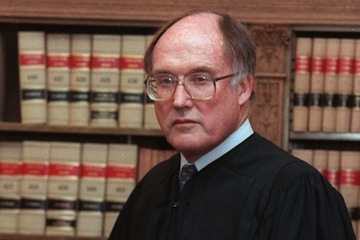The Legacy of William Rehnquist and his Court
 William H. Rehnquist
William H. Rehnquist
From the 1953 appointment of Earl Warren through the 1970s, the Supreme Court took a decidedly liberal tack in its jurisprudence. On desegregation, birth control, the rights of the accused, school busing and school prayer, and abortion, the Court issued decisions that challenged the foundations of American law and society. Critics challenged this broad interpretation of the Court's power, and one of them was William Rehnquist. Rehnquist served as Justice from 1971, and Chief Justice from 1986 through his death in 2005. He led a resurgence of conservatism and judicial restraint on the high court, though some of his more ambitious goals would be frustrated.
Rehnquist was born in Wisconsin, outside of Milwaukee, in 1924. His family was conservative and Rehnquist remained a conservative for his entire life. After serving in the military during World War II, he utilized the G.I. Bill to obtain an undergraduate education and a law degree from Stanford. He worked for 16 years in Arizona and became heavily involved in the Presidential campaign of Barry Goldwater. He was appointed to the Supreme Court by Richard Nixon in 1971, and subsequently as Chief Justice by Ronald Reagan in 1986.
Rehnquist disapproved of Earl Warren's Court, and with subsequent Chief Justice Warren Berger. Rehnquist especially disapproved of the Miranda v. Arizona decision that created the Miranda Rights, and was one of two justices to dissent on the Roe v. Wade decision that legalized abortion. He especially thought that the Court should give more credence to the Tenth Amendment and devolve more powers of government to the states.
Once Rehnquist became Chief Justice, the Court took on fewer cases and tended to take a narrower interpretation of the government's Constitutional powers. In one case, United States v. Lopez, the Court overturned a federal law prohibiting the possession of firearms in a school zone. The Solicitor General argued that such a law was Constitutional under the Commerce Clause of the Constitution, since firearms possession near schools could impair the interstate commerce of the United States by harming the quality of public education. The Court instead decided that if such a specific activity could be regulated under the Commerce Clause, then the federal government could in theory regulate almost any private activity as being detrimental to the national economy. It is one of the few cases to constrain the Commerce Clause since the New Deal era.
In general, the number of landmark cases passed down by the Court decreased greatly during Rehnquist's tenure, as compared to his predecessors. However, Rehnquist could never gain the support to overturn such decisions as Miranda or Roe v. Wade. In many ways, his tenure was more of a stalemate than a revolution.
The most famous, or infamous, case of Rehnquist's tenure was Bush v. Gore. In a 5-4 decision, decided on clearly partisan lines, the Court halted Florida's recount and assured the victory of George W. Bush. The decision depended on some out-of-character interpretations of the 14th Amendment's Equal Protection Clause from the Court's more conservative justices, who furthermore dictated that aspects of their reasoning should not be referred to as precedent on subsequent cases. Was Bush v. Gore a political decision? One simply needs to imagine the 5-4 decision that would have been passed down had the circumstances been reversed, and had Al Gore held the lead instead of Bush. The decision was clearly political, in both the majority and the dissent, and the repercussions of it were quite bitter in the U.S. at large.
Chief Justice Rehnquist passed away on September 3, 2005. President George W. Bush, the man whose election Rehnquist helped assure, appointed former Rehnquist clerk John Roberts as Rehnquist's replacement.